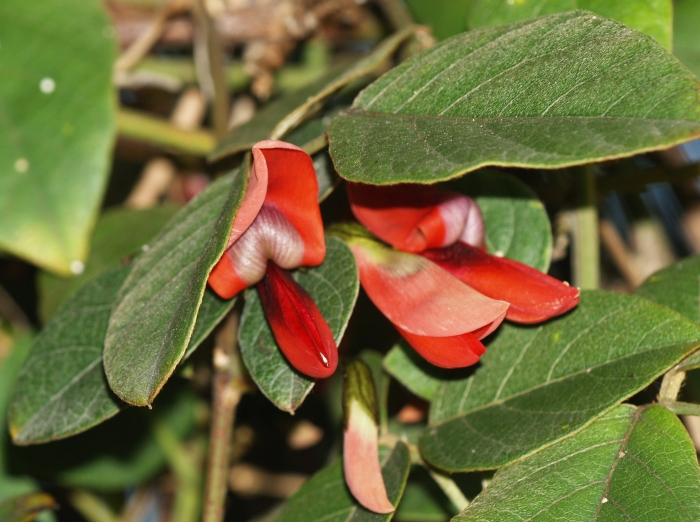Dusky Coral Pea
(Kennedia rubicunda)
Dusky Coral Pea (Kennedia rubicunda)
/
/

Sarefo
CC BY-SA 3.0
Image By:
Sarefo
Recorded By:
Copyright:
CC BY-SA 3.0
Copyright Notice:
Photo by: Sarefo | License Type: CC BY-SA 3.0 | License URL: http://creativecommons.org/licenses/by-sa/3.0/ | Uploader: Sarefo | Publisher: Wikimedia Commons | Title: Kennedia.rubicunda.1.jpg | Notes: |


































































Estimated Native Range
Summary
Kennedia rubicunda, commonly known as Dusky Coral Pea, is an evergreen perennial vine native to open eucalypt forests, coastal scrub, and heathlands in Eastern Australia. It can reach lengths of up to 13 feet and is characterized by its twining or prostrate habit, trifoliate leaves, and distinctive dark red or purple pea-like flowers. The flowering season extends from September to December, and the plant produces a rusty-hairy, flattened pod 50–100 mm long, containing ten to fifteen seeds. The flowers are moderately showy and attract pollinators such as bees.
Dusky Coral Pea is valued for its vigorous growth, making it an excellent choice for covering embankments or structures, and its ability to add a splash of color with its flowers. It is also used in native plant gardens and as a ground cover. This species is adaptable to a range of well-drained soils, from sandy to loamy, and tolerates both sun and partial shade. It is drought-resistant and has some frost tolerance, making it suitable for a variety of garden settings. Propagation is typically done by scarified seed or cuttings of semi-mature growth. While it requires low to medium amounts of water, ensuring proper drainage is crucial to prevent root rot. There are no major disease issues, but snails and slugs can sometimes be a problem. It is important to manage its growth to prevent it from becoming too invasive in the garden.CC BY-SA 4.0
Dusky Coral Pea is valued for its vigorous growth, making it an excellent choice for covering embankments or structures, and its ability to add a splash of color with its flowers. It is also used in native plant gardens and as a ground cover. This species is adaptable to a range of well-drained soils, from sandy to loamy, and tolerates both sun and partial shade. It is drought-resistant and has some frost tolerance, making it suitable for a variety of garden settings. Propagation is typically done by scarified seed or cuttings of semi-mature growth. While it requires low to medium amounts of water, ensuring proper drainage is crucial to prevent root rot. There are no major disease issues, but snails and slugs can sometimes be a problem. It is important to manage its growth to prevent it from becoming too invasive in the garden.CC BY-SA 4.0
Plant Description
- Plant Type: Vine
- Height: 4-6 feet
- Width: 2-3 feet
- Growth Rate: Moderate
- Flower Color: Red
- Flowering Season: Winter, Spring
- Leaf Retention: Evergreen
Growth Requirements
- Sun: Full Sun, Part Shade
- Water: Low, Medium
- Drainage: Medium, Fast
Common Uses
Bee Garden, Bird Garden, Butterfly Garden, Drought Tolerant, Hummingbird Garden, Low Maintenance, Potted Plant
Natural Habitat
Open eucalypt forests, coastal scrub, and heathlands in Eastern Australia
Other Names
Common Names: Red Kennedy-Pea, Red Kennedya-Pea, Red Coral-Pea, Dusky Coral-Pea, Red Kennedy Pea, Korallranka
Scientific Names: , Kennedia rubicunda, Kennedya rubicunda, Glycine rubicunda, Caulinia rubicunda, Amphodus ovatus, Kennedia oblonga, Kennedia oblongata, Kennedia phaseolifolia, Kennedia rubicunda var. robusta
GBIF Accepted Name: Kennedia rubicunda (Schneev.) Vent.